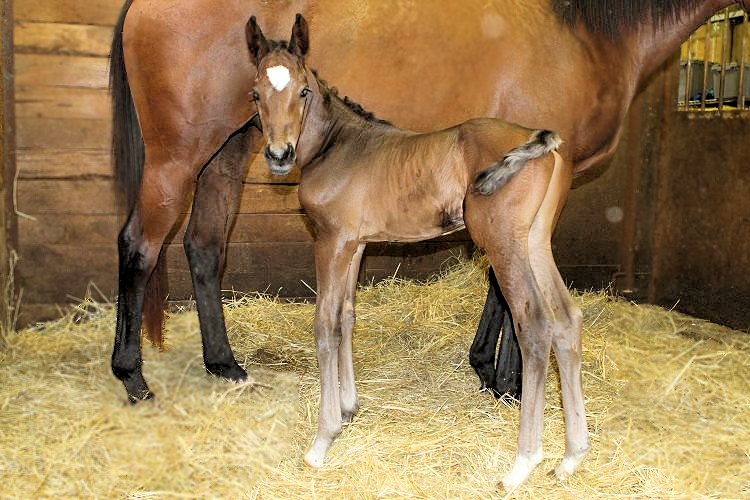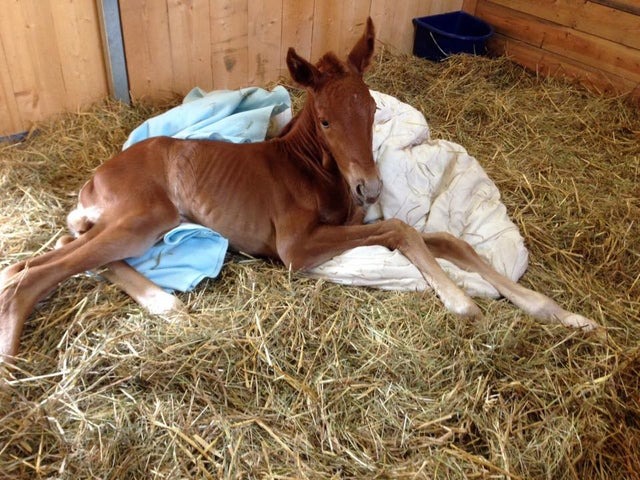The first moments after a new foal enters the world are usually gentle and predictable. Soft breathing. Careful nudges from a devoted mare. Small legs testing the ground for the very first time. Most foals follow nature’s rhythm with surprising confidence, as if guided by an ancient script written long before their birth.

But when a filly named Capri arrived, her beginning unfolded more like a question than an answer.
Those present described the scene as peaceful and full of promise. Capri’s mother, Topanga, greeted her with warm breaths and tender nudges. The little filly stretched, wriggled, and lifted her delicate head as though preparing to take her place in the world.
Everything seemed perfect.
Then the expected instinctive steps—standing, nursing, bonding—did not follow.
What happened next became a story many readers have found both moving and deeply fascinating, not only because of the emotional journey but also because it offers a glimpse into how culture, tradition, and modern science come together to support new life.
This is Capri’s story, and the broader story of a rare condition sometimes described as a foal who simply forgets how to begin.

The Moment Instinct Falters
Healthy newborn foals usually stand within the first hour and nurse shortly after. Horse breeders and caretakers have relied on this natural pattern for generations. In many cultures, these early moments are believed to reveal a foal’s future strength, spirit, and connection to the herd. Watching a young horse rise for the first time is often seen as a symbol of resilience and good fortune.
Capri, however, struggled to take this step.
Even though she wanted to nurse and repeatedly pressed herself toward her mother, she could not quite complete the action. She nuzzled instead of searching properly. She leaned without reaching. She hesitated in ways that didn’t match the usual instinctive drive seen in healthy foals.
Her mother sensed the confusion. Topanga walked in small circles, encouraging her baby with soft sounds, trying to guide her. The caretakers watched closely, understanding that newborn foals rely on early nourishment not only for energy but also for important immune support.
Despite Capri’s attempts, something wasn’t aligning—her instincts and her physical responses didn’t seem to be working together. This mismatch suggested that her system hadn’t fully transitioned into the active alertness needed for life outside the womb.

When Tradition Meets Veterinary Insight
Horse communities around the world have long held beliefs about the earliest hours of a foal’s life. Some see these moments as spiritually significant, while others focus on the symbolic bond between mare and foal. Stories of unusual births often become part of local lore, shared for years as reminders of nature’s unpredictability.
Yet in Capri’s case, science offered a clear explanation for what was unfolding.
The farm’s veterinary team recognized the signs immediately. The filly was awake, yet not fully responsive in ways that newborn foals typically are. After a gentle assessment, the vet suggested Capri might be experiencing Neonatal Maladjustment Syndrome, often referred to informally as “dummy foal syndrome.”
This term does not imply anything negative about the foal. Instead, it describes a temporary state in which a newborn’s brain has not completely adapted to external life. Although the condition is rare, it has been observed in farms around the world and is well-documented in veterinary literature.
One widely discussed theory suggests the following:
A foal inside the womb remains calm due to the consistent gentle pressure of the birth canal. This pressure may help keep the foal’s nervous system in a safe, quiet state. When the foal is born, the release of this pressure is believed to signal the brain to “switch on,” allowing the newborn to stand, search, and nurse.
In some cases—particularly after unusually fast births—experts speculate that this natural transition might not occur smoothly.
Capri appeared alert, but her instincts seemed paused, as if her inner system still believed she had not completed the passage into the outside world.
The Madigan Squeeze: A Gentle, Innovative Technique
When the vet proposed a procedure known as the Madigan Squeeze, the caretakers listened carefully. Though not widely known outside equine communities, the method has gained recognition for helping foals experiencing delayed adaptation.
The technique uses soft ropes to gently recreate the calm pressure similar to what a foal feels during birth. The filly is held in this secure position for a short period before being released, which, according to veterinarians, may help stimulate the neurological shift needed to activate natural instincts.
Topanga stayed close throughout the process, responding with quiet trust. Her presence offered the emotional grounding that many horse owners and trainers view as essential. Around the world, the bond between a mare and her foal is regarded as one of the strongest in nature, often symbolizing guidance, protection, and unconditional acceptance.
When the gentle pressure was applied, Capri relaxed completely, entering a quiet state. After several minutes the ropes were removed. What followed was subtle but extraordinary.
The filly blinked.
She lifted her head.
She steadied her legs.
And then, for the first time since her birth, she walked with purpose straight toward her mother.
She nudged.
She searched.
She latched.
The caretakers described the moment as a wave of relief. Topanga wrapped her neck around her foal, and Capri nursed confidently as though she had finally found the missing link that her body had needed to begin her journey.

A Story of Renewal and Learning
After her first successful feeding, Capri became stronger with each passing hour. Caretakers monitored her closely, ensuring she continued nursing well and responding normally. Her movements grew steadier. Her ears twitched with alertness. She gained the lively curiosity that makes young foals so enchanting.
Topanga’s nurturing presence played a key role in her recovery. Many horse owners believe that a strong maternal connection contributes to a foal’s emotional stability, and modern behavioral studies support the idea that early bonding can positively influence a young horse’s development.
Capri’s experience highlights the unique balance between instinct, tradition, and science. Her story illustrates how attentive caretaking, cultural respect for animals, and veterinary knowledge can work together to guide a newborn through a challenging moment.
The Cultural Symbolism of New Beginnings
Across different cultures, the birth of a foal is often associated with optimism. Horses have long been held as symbols of strength, companionship, and freedom. In certain traditions, a foal’s first successful steps represent progress, hope, and the promise of future journeys.
Stories like Capri’s often resonate because they reinforce a timeless truth: beginnings may not always be perfect, but the path forward can still be bright. Many communities pass down tales of young animals who overcame early challenges, viewing these accounts as reminders of resilience and the unexpected ways life can unfold.
Capri’s journey, though grounded in real veterinary science, also fits naturally into this larger cultural tapestry. Her experience becomes not only a medical case but also a gentle symbol of second chances and the quiet support that makes them possible.

Science, Compassion, and the Lessons They Offer
Modern veterinary understanding continues to evolve, giving caretakers tools to identify and respond to unusual situations with greater confidence. Neonatal Maladjustment Syndrome remains a topic of ongoing research, with professionals studying how foals adapt to life outside the womb and how supportive techniques may aid them when instinct is delayed.
Capri’s story demonstrates how early recognition and calm, informed responses can make a meaningful difference. It reminds caretakers of the importance of observing small signs, maintaining strong relationships with veterinary professionals, and responding with patience.
Although not all cases follow the same path, Capri’s experience offers valuable insight into how science and compassionate care can work together to support new life.
A Reflection on Human Curiosity
Stories like Capri’s touch us because they blend the wonder of nature with the reassurance of knowledge. They invite us to see animals not only as creatures of instinct but also as individuals who benefit from attentive care. Even when something unfolds in an unexpected way, curiosity and understanding help guide both caretakers and animals toward positive outcomes.
Capri reminds us that beginnings can be uncertain, but with guidance, patience, and a willingness to learn, new life often finds its way. Her story encourages us to keep exploring, keep observing, and keep appreciating the many remarkable moments—large and small—that deepen our connection to the living world.
Sources
daily.tiemgo.vn
The Little Foal Who Forgot How to Join the World – Daily News
TheFencePost.com – Equine Care Resources
Brechfa Farm Stud – Educational Articles on Foal Development
